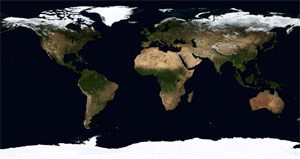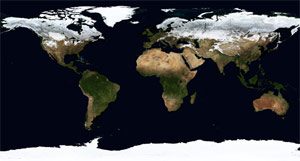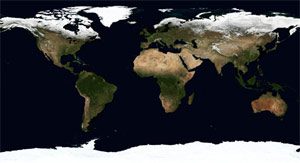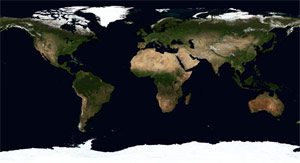Within a year, ice and snow cascade down to the south and then retract back to the north. Entire continents freeze and then thaw out. In spring, a green carpet of vegetation spreads widely. It becomes the most vibrant and lively during summer, fades in autumn, and disappears when winter arrives.
One of the most famous photographs ever taken by an astronaut aboard Apollo 17 in 1972, while en route to the moon, is known as Blue Marble. The image showcases southern Africa and Antarctica beneath swirling white clouds, contrasting with the deep blue of the ocean.
Since then, every few years, NASA has released new images of the Earth, continuing to call them Blue Marble after the original photograph. The latest series is titled Blue Marble: Next Generation, depicting a cloud-free Earth changing through the four seasons.
Autumn: Countries such as Indonesia and Thailand in Southeast Asia remain humid and lush, benefiting from the last summer rains. In northern Asia, temperatures drop and snow clouds begin to form, preparing for their southward journey into winter. The green vegetation of the northeastern United States and western Canada gradually shifts to a reddish-brown hue as the leaves in the region change color, die, and fall from the branches.
 |
|
Autumn |
Winter: Most of the Northern Hemisphere is covered in ice and snow. The exceptions are the eastern coast of the United States and parts of western Europe, particularly Scotland and England. A warm water current called the Gulf Stream runs along the coast of these regions, shielding them from the full force of the harsh winter. In Africa, heavy clouds have moved south, and the southern tip of the continent remains the greenest, thriving year-round. In summer, these clouds will drift northward, bringing gifts of rain.
 |
|
Winter |
Spring: The boundary of ice and snow in North America and Asia begins to push northward. A light green expanse forms in the southeastern United States, which will spread across the continent in summer. Heavy rain clouds in South America drift from west to east, making the eastern parts of the continent visibly greener.
 |
|
Spring |
Summer: The snow cover that blankets most of Asia in winter has shifted, shrinking under the sun, becoming a small white cap near the Arctic. Even Alaska cannot resist the heat of summer. Rain-bearing clouds have moved to North Africa, and the central regions of the continent are greener than ever. The largest deserts in the world – the Sahara in Africa, the Gobi in Asia, and most of Australia – change very little seasonally, looking the same in both winter and summer.
 |
|
Summer |
These images are compiled from thousands of photographs taken by NASA’s MODIS satellite.
T. An (according to LiveScience)


















































